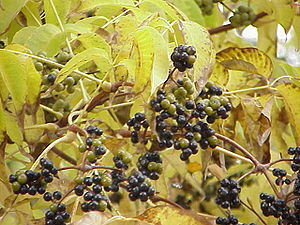Note: This is a project under development. The articles on this wiki are just being initiated and broadly incomplete. You can Help creating new pages.
Phellodendron - Cork-tree
Cork-tree or Phellodendron, is a genus of deciduous trees in the family Rutaceae, native to east and northeast Asia. It has leathery, pinnate leaves and yellow, clumped flowers. The name refers to the thick and corky bark of some (but not all) species in the genus.
Contents
Uses
Psoriasis, Ulcers, Osteoarthritis, Obesity, Diabetes, Meningitis, Pneumonia, Diarrhea, Eye infections.
Parts Used
Chemical Composition
The major chemical constituents in the bark of P. amurense are alkaloids of the isoquinoline type. Alkaloids isolated from the bark of P. amurense are berberine, palmatine, magnoflorine, phellodendrine, candicine , and jatrorrhizine. Phellodendrine is an alkaloid of the protoberberine type, whereas candicine is an aliphatic quaternary ammonium compound.[1]
Common names
| Language | Common name |
|---|---|
| Kannada | |
| Hindi | |
| Malayalam | |
| Tamil | |
| Telugu | |
| Marathi | NA |
| Gujarathi | NA |
| Punjabi | NA |
| Kashmiri | NA |
| Sanskrit | |
| English | Agrimony |
Habit
Identification
Leaf
| Kind | Shape | Feature |
|---|---|---|
| opposite | pinnately compound | 5 to 11 leaflets per leaf and leaves are 10" to 15" long |
Flower
| Type | Size | Color and composition | Stamen | More information |
|---|---|---|---|---|
| Unisexual | 2-4cm long | greenish-yellow | 5-20 | not ornamentally significant blooms in late May and early June |
Fruit
| Type | Size | Mass | Appearance | Seeds | More information |
|---|---|---|---|---|---|
| pea-sized fruits | aromatic when crushedonly on female plants held in clusters | change from green to black | {{{6}}} |
Other features
List of Ayurvedic medicine in which the herb is used
- Vishatinduka Taila as root juice extract
Where to get the saplings
Mode of Propagation
How to plant/cultivate
As an ornamental plant, Phellodendron is a tree for all seasons. In spring it has yellow flowers, in summer it provides foliage and shade, in fall the leaves turn bright yellow, and the textured bark and winding branches add interest in the winter.[3]
Commonly seen growing in areas
Tall grasslands, meadows, Borders of forests and fields.
Photo Gallery
References
External Links
- Pages that are stubs
- Ayurvedic Herbs known to be helpful to treat Psoriasis
- Ayurvedic Herbs known to be helpful to treat Ulcers
- Ayurvedic Herbs known to be helpful to treat Osteoarthritis
- Ayurvedic Herbs known to be helpful to treat Obesity
- Ayurvedic Herbs known to be helpful to treat Diabetes
- Ayurvedic Herbs known to be helpful to treat Meningitis
- Ayurvedic Herbs known to be helpful to treat Pneumonia
- Ayurvedic Herbs known to be helpful to treat Diarrhea
- Ayurvedic Herbs known to be helpful to treat Eye infections
- Herbs with Fruits used in medicine
- Herbs with common name in English
- Habit - Deciduous tree
- Index of Plants which can be propagated by Seeds
- Herbs that are commonly seen in the region of Tall grasslands
- Herbs that are commonly seen in the region of meadows
- Herbs that are commonly seen in the region of Borders of forests and fields
- Herbs



